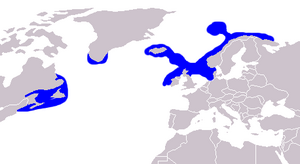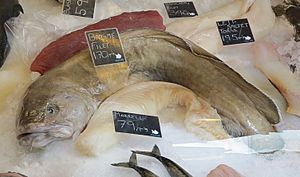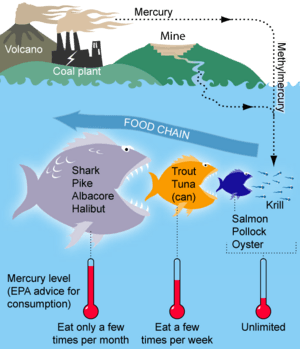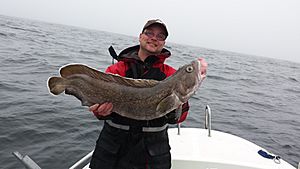Cusk (fish) facts for kids
Quick facts for kids Cusk |
|
|---|---|
 |
|
| Scientific classification | |
 |
|
| Distribution of cusk (in blue) | |
| Synonyms | |
|
The cusk (also called tusk) is a type of fish found in the North Atlantic. It looks a bit like a cod and belongs to the ling family. The cusk is special because it's the only species in its group, called Brosme. People sometimes call it by other names like Torsk or European Cusk.
Contents
About the Cusk Fish
The cusk is easy to spot among other cod-like fish. It has only one dorsal fin (the fin on its back). Its dorsal, caudal (tail), and anal fins are connected at the bottom. However, they have deep cuts that make them look like separate fins. The tail fin is also perfectly rounded.
What Cusk Look Like
Cusk fish can be different colors. They might be dark gray or reddish-brown on top. Their lower sides and belly are usually lighter gray. Older cusk are often plain colored. Younger cusk sometimes have yellow stripes across their sides.
How Big Do Cusk Get?
A cusk can grow up to about 4 feet (120 cm) long. The heaviest cusk ever caught weighed around 45 pounds (20 kg). The world record for a cusk caught by fishing is 37 pounds, 14 ounces (17.20 kg). This huge fish was caught by Anders Jonasson near Sørøya in northern Norway.
Where Cusk Live
Cusk live on both sides of the North Atlantic. They prefer moderately deep water. Along the North American coast, you can find them as far south as Cape Cod and sometimes even off New Jersey. Their home range covers most of the North Atlantic. This includes the waters around Iceland and the coast of Norway. They are also found on the Mid-Atlantic Ridge.
Cusk Movement and Deep Water
Cusk don't move around much over long distances. This is especially true when deep water areas surround them. For example, populations on the Mid-Atlantic Ridge and the Rockall Bank don't mix much. This suggests that deep water acts like a barrier for adult cusk. Even though their eggs and young larvae float, they don't travel far.
Cusk Habitat Preferences
Cusk usually live in water deeper than 600 feet (200 to 500 meters). They almost always prefer rough ocean bottoms. These areas have lots of rocks, ledges, or gravel. Good fishing spots for cusk are often small. This is different from fish like cod, haddock, or pollock. Cusk are ocean fish and are rarely found in harbors.
Cusk vs. Burbot
It's important not to confuse the cusk with the Burbot. The burbot is sometimes called the "freshwater cusk." However, it lives in fresh water and belongs to a different group of fish.
Cusk and Pollution
Like many other ocean animals, cusk are affected by pollution. One type of pollution that impacts cusk is mercury. In water, mercury can change into a very harmful form called methylmercury (MeHg). This harmful mercury can build up in living things. It also increases as it moves up the food web. This process is called biomagnification.
How Mercury Affects Cusk
Cusk are a food source for many other creatures. This means that the toxins they collect over time can affect any animal that eats them. This includes humans. Studies in Norway and other parts of Europe show that wild ocean fish often have the most mercury. Sometimes, the mercury levels are higher than what is considered safe for food.
Sources of Mercury in Water
Mercury often enters rivers from land. Then, it flows into the ocean where cusk live. This is why ocean fish can have more mercury. Also, mercury levels are often higher in fjords than in open coastal areas. This might be because of the shape of fjords. It could also be due to local human activities that cause pollution.
Cusk Habits
Cusk lay their eggs in the spring and summer. This usually happens between April and early July. A female cusk of average size can produce over two million eggs. These eggs float in the water.
Young Cusk Life
Young cusk live near the surface of the water until they are about 2 inches (5 cm) long. After that, they move to rocky ocean floors in deep water.
What Cusk Eat
Cusk are strictly bottom-dwelling fish. They are slow swimmers and not very strong. They mostly eat crustaceans (like crabs and shrimp). They also eat other soft-bodied invertebrates and mollusks (like snails and clams).
Fishing for Cusk
Cusk are mainly caught off the North American coast. This includes areas near the state of Maine and the Canadian Maritimes.
Commercial Cusk Fishing
In the Gulf of Maine, cusk are mostly caught using hooks and lines. Large fishing lines with many hooks, called line trawls, catch most of the cusk for sale. Most cusk are caught during the winter and spring. The cusk caught for sale are usually between 1 and 2 feet long (30–60 cm). They weigh about 5 pounds (2 kg) on average.
Cusk as Food
Cusk is a very good fish to eat. It is sold fresh or frozen as fillets. Some of the cusk caught is also smoked.

Protecting Cusk
Fisheries and Oceans Canada (DFO) believes that cusk are an endangered species. This was based on a report from 2012. The report showed that the number of cusk caught in surveys dropped by about 90% from 1970 to the late 1990s.
Fishing Limits and Bycatch
To help protect cusk, a limit was set on how many could be caught. In 1999, only 1000 metric tons were allowed in one fishing area. This limit was lowered to 750 metric tons in 2003 and covered more areas. Even with these rules, cusk are still often caught by accident. This happens in fishing for other fish like lobster. You can still find cusk in supermarkets in Atlantic Canada, even though they are considered threatened.
US Conservation Efforts
In the United States, the Cusk is a "Species of Concern" for the National Marine Fisheries Service. This means they are worried about the cusk's status and threats. However, there isn't enough information to list them under the Endangered Species Act (ESA) yet. In 2007, the National Marine Fisheries Service started a review. They wanted to see if the cusk needed to be listed under the ESA.




